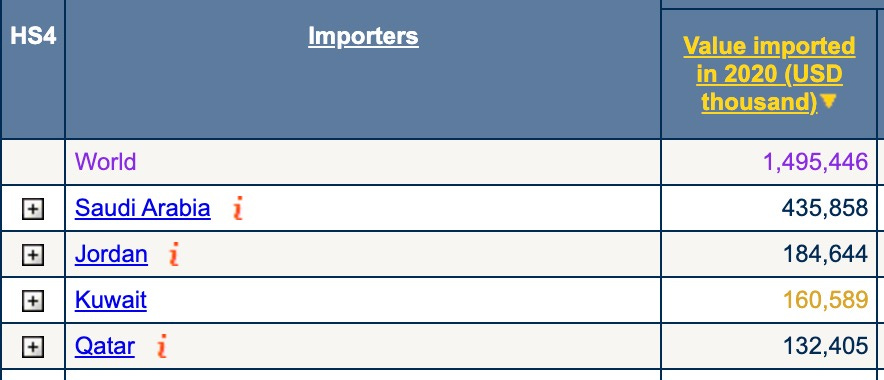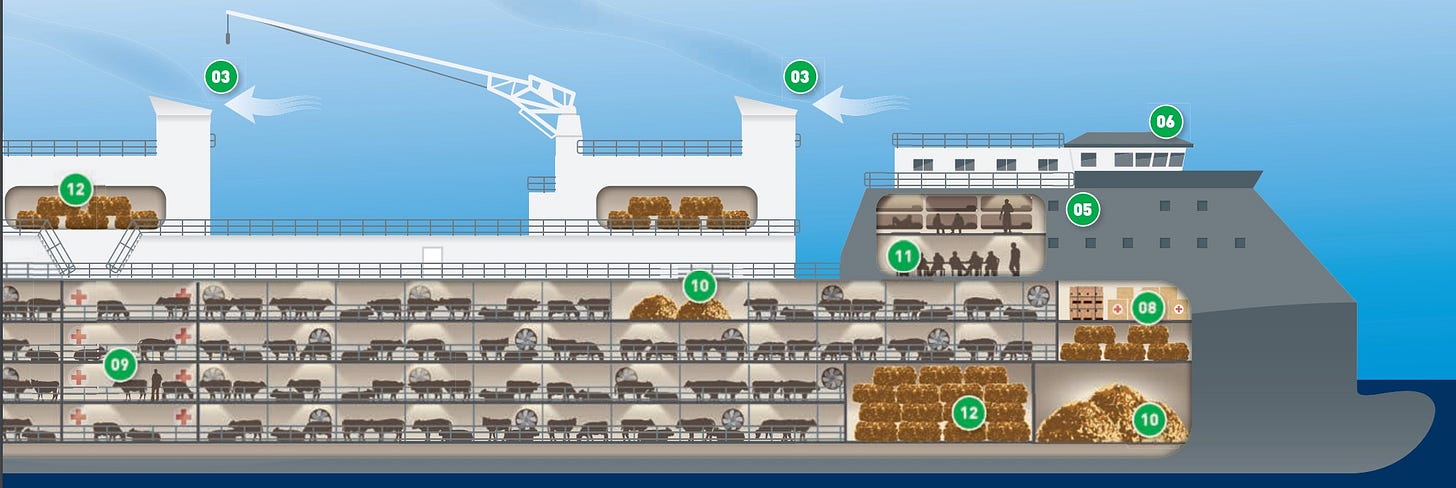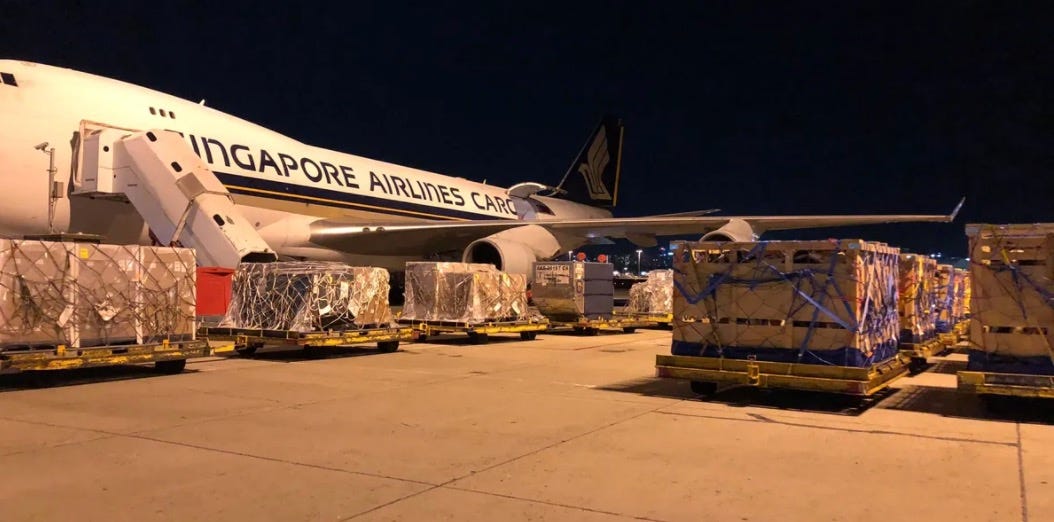Sea cowboys & flying sheep
Prime Future 72: the newsletter for innovators in livestock, meat, and dairy
New to Prime Future? Welcome! Subscribe to get weekly content to your inbox.
I love the messiness & complexity & massive scale of the global animal protein business, that there's always something to learn, new corners of the industry. Today’s topic is definitely an obscure little corner of the industry. We usually look at big picture accelerating trends in Prime Future but this one is both tiny picture and a trend that is, at best, unlikely to grow. But it’s interesting, so here we go 😁
In exploring how feed, livestock, and meat move around the world I stumbled on a post WW2 story of some church groups who wanted to take livestock to regions where the local livestock population had been destroyed in the war. These 'sea cowboys' as they were called, put livestock (and themselves) on ships to deliver the animals to war ravaged parts of Europe. Turns out, the sea cowboys were the origin of Heifer International, the non-profit who's model is built around creating long term economic sustainability through livestock.

Why are we talking about sea cowboys in the midst of a series on how supply chain chaos is impacting livestock, meat & dairy?
First, let's generalize the flow of livestock related stuff (at least within the US):
Feed ingredients shipped primarily via rail to feedmills, then feed is shpped via truck to producers
Animals shipped primarily via truck from point to point, ultimately to processing plants
Meat shipped primarily via truck within the US, before being put on ships for export outside of North America
Shipping chilled or frozen meat around the globe is it’s own complex thing that we’ll come back to at some point because cold chains might be one of the highest impact innovations of all time. But meat isn't the only thing exported, live animals are also exported.
The global annual value of live animal exports is $24 billion. Put that in perspective - that's roughly the equivalent of the entire US swine industry. It’s also a tiny little speck of the ~$800B global meat business.
Being from Arizona, when I hear 'live animal exports' I think about feeder cattle from Mexico brought into the US but there's a whole world out there beyond. In fact, every day there are five million head of livestock criss crossing the oceans of the world. That seems like something worth looking into for curious people like us…
Who’s shipping livestock where?
Ok, so that $24B global ‘live animal export’ includes the mundane, like live cattle import from Mexico into the US or live pigs exported from Canada to the US, a combined ~$2-3B. It also includes a lot of movement of live animals across borders within the EU, ~$10B. Those animals are put on a truck and moved to their new country, and outside of additional regulations, it's no different than moving pigs from Minnesota to Iowa or some other interstate movement within the country. So that’s not super interesting, let’s set all that aside.
A large portion of the remainder of animals represented in that $24B, are moving via water, or even air(!), from country A to country B. Now that’s interesting.
Let’s call this segment the Plane & Ship Animals. It seems to be worth about ~$10B globally annually, a rounding error in the grand scheme. Maybe I’m alone in this intrigue, but that rounding error of a supply chain of live animals moving via ships & planes is not a supply chain I’ve spent much time around. I have some questions…
Who: who is shipping animals to whom?
The Plane & Ship Animals are largely moving from Australia and the EU to the Middle East & northern Africa.
After the US (with imports from Mexico & Canada), China is the largest importer of live bovines. After a trade deal struck a few years ago, Australia has a growing live export to China of both beef cattle for feedyards and dairy heifers. That growing export to China pales in comparison to Australia cattle exports to Indonesia.
(Interestingly, dairy heifer exports to China is one of the reasons that the beef-on-dairy genetics strategy is much more challenging to implement in Australia than the US right now - the math on ‘next best alternative’ is very different in the two countries.)
There is also a large & established trade of slaughter ready sheep shipped from Australia to the Middle East. Here’s a numeric look, according to Trade Map:
How: how are live animals shipped by air and sea?
Let’s start with export via water, enabled by cargo carriers converted to livestock carriers. One livestock carrier is equipped to handle 75,000 sheep or 18,000 cattle. (Cruises are my nightmare, this is now my meta nightmare🤢)
Here’s how an Australia industry group describes some of the mechanics:
“Desalination equipment produces fresh drinking water from sea water. Additional water supplies are carried on board together with spare parts to quickly repair the system and maintain water supply in case of a mechanical breakdown.”
“Fresh air is continuously circulated by a powerful ventilation system. This is constantly monitored and alarms alert the crew to any changes. Additional electrical generators and spare parts enable air circulation to continue in case of a mechanical breakdown.”
“A ship may have two engines or additional generators in case of a mechanical breakdown, to ensure continued operation of ventilation, lighting, water desalination, feed and water distribution, and refrigeration systems.”
Ok so obviously I know shipping animals across the world’s ponds isn’t new, but I didn’t realize the scale of it today. But think about the shrink on a load of cattle moving 100 miles…that has to be miniscule compared to the shrink on livestock shipped on a livestock carrier ship, right? So then it’s not hard to imagine that higher value animals are much more likely to be transported by plane than ship.
Here’s what Live Air Australia says about exporting animals via plane:
Livestock are contained within crates and can be transported in the lower bellyhold of passenger flights or on freighter aircrafts.
Each animal is transported in a specifically designed crate for the animal type. Allowing room for the animal to move freely, good ventilation and specifically designed flooring to keep the crates and aircraft clean from livestock excreta.
Livestock can be transported to Asia within 24 hours or Europe within 36 hours. Ideal for pregnant livestock or accessing global destinations that have climatic challenges or new markets.
With numerous departure dates and locations, air transport is a viable alternative for land locked areas for all types of animals, no matter how many livestock are required.
(It turns out that Houston-Bush Intercontinental Airport has a Livestock Facility, so there’s some helpful holiday dinner trivia.)
I do not know the cost comparison of shipping livestock via ship vs plane, but it does raise some questions about what ‘high value’ means in this context and when plane travel pencils out, like for high value dairy heifers.
Why: what’s the business rationale for shipping live animals on planes & ships?
The real question is, what are the operational and market contexts that make exporting live animals the better option to exporting meat?
There are 3 potential markets live animal exports are destined for: breeding, feeding, and slaughter. I couldn’t find any good estimates breaking down the % of each of the total live animal export, let alone those percentages within the Plane & Ship Animals (the ~$10B). So we’re in hypothesis territory now.
The animals intended for slaughter are largely sheep headed to the Middle East for local slaughter for religious reasons. It’s not an economic question of whether it’s more cost efficient to ship carcasses/primals or to ship live animals. The customer demand is for live animals, so that’s what the market delivers….where there’s a market, there’s a way. ✅
Of the Plane & Ship Animals (ignoring the trade within North America or the EU), the animals being shipped to then be fed to market ready weights seem likely to be driven by regions where demand for meat is outpacing production capacity. I’m surmising that those same regions are also building up their breeding herds as well, so shipping breeding animals is either about expanding quickly or expanding better through improved genetics, or both. Whether due to re-population after disease outbreaks, or extended droughts, or any other cause of a previous herd reduction trend that needs to be reversed. Or simply the rapid rise of a middle class ready to level up their diet with animal protein, e.g. China.
But that raises the question, in an era of vastly accelerating technology to accelerate genetic progress, why would a producer import bulls instead of semen? Or heifers instead of embryos? Some version of ‘speed to offspring’ seems to be the likely answer?
As you can imagine, there is enormous animal welfare pressure around live animal exports (all variations, but especially shipped via livestock carriers) and when trying to find info on this space there is way more perspective available from activists than from industry (shocking, I know). The debate seems to be whether animals intended for slaughter should be shipped, or only animals intended for breeding and everything else going in carcass form. Regulations vary from country to country and fluctuate, like New Zealand’s ban on live animal export for slaughter a few years ago.
One thing the live animal export industry has going for it? While ports are backed up waiting to unload cargo ships, livestock carriers dock and unload at designated facilities so they aren't impacted by the current dynamics wreaking havoc in the rest of the shipping sector. Although, I suppose you do need labor to unload livestock....
Live animal export is a tiny slice of the global protein industry pie but high value niches can make non-obvious operational decisions look obvious…like flying first class sheep across the world.
If you’re geeking out & need to see a bit more…
Here’s a video of Jersey heifers prepping to leave North Carolina for Qatar:
And this one takes a look at the process for sheep, cattle, swine, and goats leaving Australia (Planes & Ships):
I’m interested in all things technology, innovation, and every element of the animal protein value chain. I grew up on a farm in Arizona, spent my early career with Elanco, Cargill, & McDonald’s before moving into the world of AgTech & early stage companies.
I’m currently on the Merck Animal Health Ventures team. Prime Future is where I learn out loud. It represents my personal views only, which are subject to change…’strong convictions, loosely held’.
Thanks for being here,
Janette Barnard






